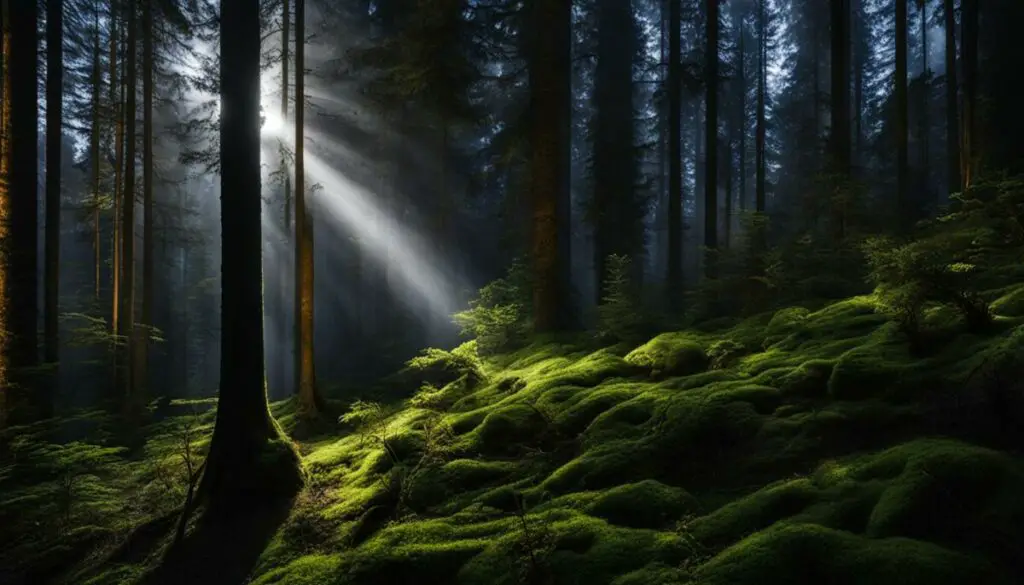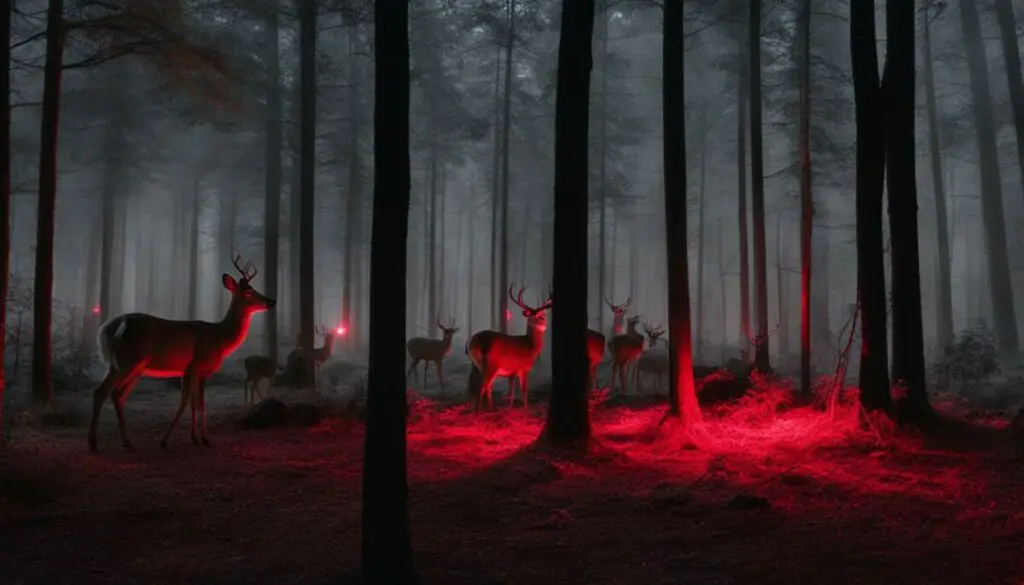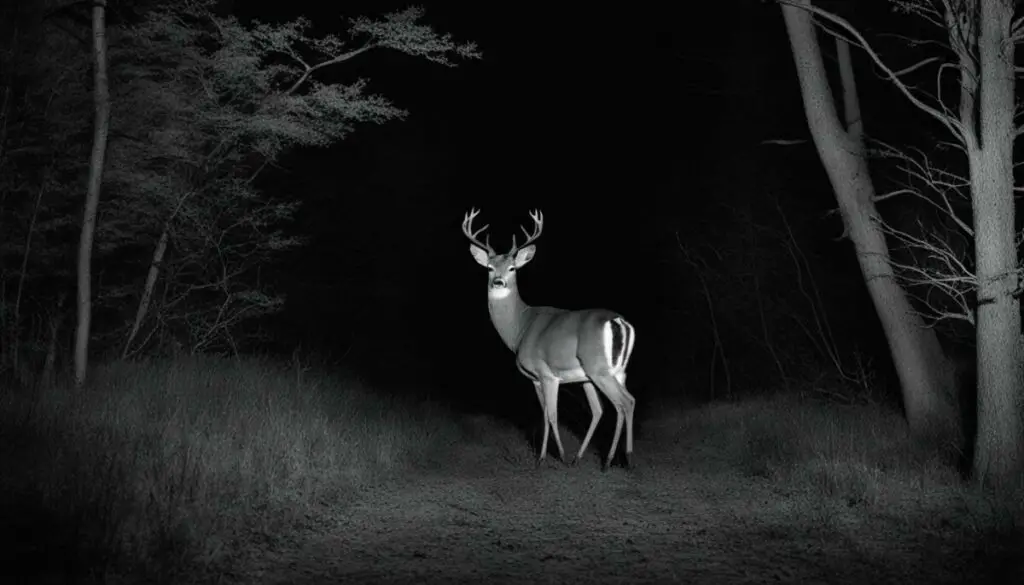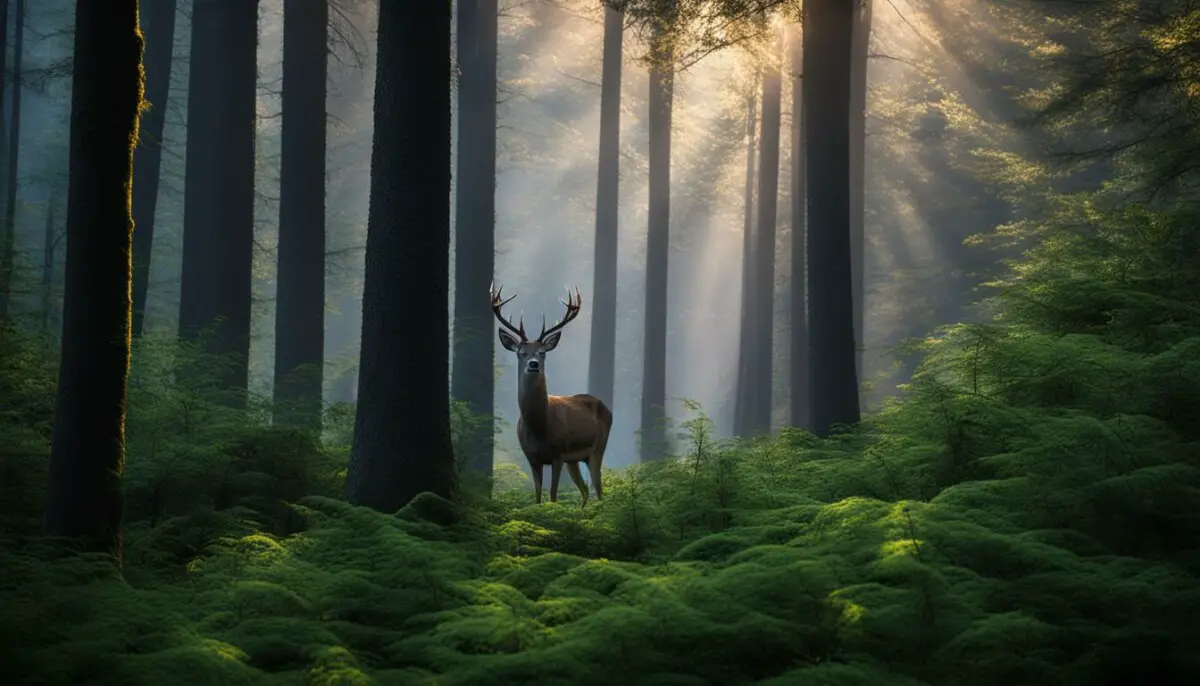Last Updated on 5 months by Francis
Deer are a common sight in the wilds of North America, captivating hunters, researchers, and wildlife enthusiasts alike. As these individuals venture into the field, many rely on infrared illuminators to aid their activities. But can deer see these invisible beams of light? In this article, we delve into the vision of deer and explore whether they possess the ability to perceive infrared light. Join us as we unravel the science behind deer’s vision and its interaction with infrared technology.
Contents
Key Takeaways:
- Deer’s eyes are not designed to detect infrared light
- Infrared illuminators emit wavelengths that are invisible to deer but can be detected by their thermoreceptors
- Understanding deer’s vision is crucial for hunting, research, and wildlife observation
- Choosing the right camera flash, such as infrared or invisible flash, minimizes the chances of spooking deer
- Moultrie offers a range of stealthy cameras, including infrared and invisible flash options, for various outdoor activities
Understanding Infrared Light and its Properties

Infrared light, a form of electromagnetic radiation, plays a crucial role in various fields, including thermal imaging, communication, and sensing. It has longer wavelengths than visible light, ranging from 800 nm to 1 mm, making it invisible to the naked eye. However, infrared light can be detected using specialized devices such as thermal imaging cameras and infrared sensors.
One key characteristic of infrared light is its ability to carry heat energy. This property makes it particularly useful in thermal imaging cameras, which can detect and display heat signatures. By measuring the intensity of infrared radiation emitted by objects, these cameras create images that reveal variations in temperature. This technology finds applications in diverse industries, including security, medicine, and environmental monitoring.
Understanding the properties of infrared light is essential for comprehending how it interacts with the vision of animals such as deer. While these creatures cannot see infrared light, they possess other sensory mechanisms, such as thermoreceptors, that enable them to sense and respond to changes in temperature, including infrared radiation. By exploring the science behind infrared light, we can gain insights into how it impacts the natural world around us.
Table: Properties of Infrared Light
| Property | Description |
|---|---|
| Wavelength | Longer than visible light, ranging from 800 nm to 1 mm |
| Invisibility | Not detectable by the naked eye |
| Heat Transmission | Carries heat energy and can be used in thermal imaging |
| Thermoreceptor Sensitivity | Can be detected by animals with specialized thermoreceptors |
The Vision of Deer

Deer have a unique visual field that allows them to spot potential threats from a distance. Their wide visual field covers an impressive 310 degrees, surpassing that of humans. This wide field of view helps deer detect predators and stay alert in their natural habitat.
However, despite their broad visual field, deer do not excel in detail and color perception. Their eyes are dichromatic, meaning they can only see short blue wavelengths and long green wavelengths. They struggle to differentiate between shades of green and cannot perceive red, yellow, or orange wavelengths, which are important for detecting ripe fruits and berries.
While deer may not have the same color perception as humans, they rely on other senses, such as their acute hearing and sense of smell, to navigate their surroundings and find food. Their eyesight is specifically designed for survival in the wild, allowing them to remain vigilant and avoid potential threats.
Quotes:
“Deer have a wide visual field that helps them spot predators and stay alert in their natural habitat.”
“Their eyes are dichromatic, limiting their color perception to blue and green wavelengths.”
“Deer rely on their acute hearing and sense of smell, in addition to their eyesight, to navigate their surroundings.”
Table: Deer’s Color Perception
| Color Wavelength | Perception by Deer |
|---|---|
| Short blue wavelengths | Visible |
| Long green wavelengths | Visible |
| Red wavelengths | Invisible |
| Yellow wavelengths | Invisible |
| Orange wavelengths | Invisible |
Can Deer See Infrared Light?

Deer’s sensitivity to infrared light has long been a topic of debate among hunters and wildlife enthusiasts. While deer have exceptional eyesight, their visual capabilities are limited when it comes to detecting infrared radiation. Deer cannot see infrared light, as their eyes are not designed to perceive wavelengths longer than 720 nm, which falls within the visible light spectrum.
This means that deer are unable to detect heat signatures or objects emitting infrared radiation. However, it’s important to note that deer have other senses, particularly their thermoreceptors, which allow them to sense and detect changes in temperature, including infrared radiation.
Understanding the limitations of deer’s eyesight and their inability to see infrared light is crucial for those using infrared technology for hunting or research purposes. It ensures that the presence of infrared illuminators or thermal imaging cameras does not startle or affect the behavior of deer. Instead, these devices provide humans with the ability to see in low-light conditions and help detect heat signatures and wildlife activity without disrupting the natural behavior of deer.
Table: Deer’s Sensitivity to Infrared Light
| Deer Perception | Infrared Light |
|---|---|
| Ability to See | No |
| Wavelength Range | Up to 720 nm (visible light spectrum) |
| Ability to Detect Heat Signatures | Yes, through thermoreceptors |
While deer cannot see infrared light, they are highly sensitive to their surroundings and can detect changes in their environment through their other senses. By taking these factors into consideration and choosing the right equipment, hunters and researchers can effectively track and observe deer without unnecessarily disturbing them.
Infrared Technology for Hunting and its Implications for Deer Behavior
When it comes to hunting, technology plays a crucial role in enhancing the effectiveness and efficiency of hunters. In recent years, infrared technology has gained significant popularity among hunters for its ability to provide clear visibility in low-light conditions. Thermal cameras, in particular, have revolutionized the way hunters track and observe deer. These cameras utilize infrared radiation to capture heat signatures, allowing hunters to detect the presence of deer even in complete darkness.
The use of thermal cameras in hunting has several implications for deer behavior. Unlike traditional hunting methods that rely on visible light, thermal cameras emit infrared radiation that is invisible to deer. This means that the presence of thermal cameras is unlikely to startle or spook deer, as they are unable to perceive the infrared light emitted by these devices. As a result, hunters can observe deer in their natural habitat without alerting them to their presence, enabling more accurate tracking and research.
However, it is important to note the limitations of deer eyesight. While they cannot see infrared light, deer have other heightened senses, such as hearing and smell, that they rely on to detect potential threats. Therefore, hunters using thermal cameras should still exercise caution and take additional measures to mask their scent and minimize noise to avoid alarming nearby deer. By understanding these limitations and incorporating infrared technology strategically, hunters can optimize their hunting experiences while respecting the natural behavior of deer.
Invisible to Deer, Visible to Humans: Infrared Illuminators

When it comes to deer, what is invisible to them can be visible to us. This is the case with infrared illuminators, which emit infrared radiation that deer cannot see but can be detected by their thermoreceptors. Infrared illuminators are valuable tools for hunters and researchers alike, providing a source of lighting in the infrared spectrum without alerting or spooking the deer.
Using infrared illuminators, humans can see in low-light conditions and detect heat signatures and wildlife activity. This technology is particularly useful for hunters who need to track game or researchers studying the behavior of deer and other wildlife. By illuminating the surroundings with infrared light, hunters can maintain their stealth while observing the movement and behavior of deer and other nocturnal animals.
Infrared illuminators offer a significant advantage over traditional light sources, as they do not startle deer or interfere with their natural behavior. This is crucial for hunters who rely on stealth and minimal disturbance to increase their chances of a successful hunt. Additionally, researchers can benefit from using infrared illuminators as they can capture valuable data without disrupting the natural habitat and behavior of the animals they study.
Table: Comparing Visible Light and Infrared Illuminators
| Aspect | Visible Light Illuminators | Infrared Illuminators |
|---|---|---|
| Visible to Deer | Yes | No |
| Visible to Humans | Yes | No |
| Startle Deer | Yes | No |
| Interfere with Natural Behavior | Yes | No |
| Ability to Detect Heat Signatures | No | Yes |
Choosing the Right Camera Flash for Deer Tracking

When it comes to deer tracking, choosing the right camera flash can make a significant difference in the success of your endeavors. Different types of camera flashes offer unique advantages and drawbacks, so it’s essential to understand their characteristics before making a decision.
Infrared Flash Cameras
Infrared flash cameras emit light in the infrared spectrum, which is invisible to deer. This makes them an excellent choice for minimizing the chances of spooking deer during tracking. There are two common types of infrared flash cameras: low-glow and no-glow. Low-glow cameras produce a faint red glow that is difficult for deer to detect, while no-glow cameras emit no visible light.
White Flash Cameras
White flash cameras produce full-colored photographs, which can be beneficial for capturing fine details. However, the bright flash produced by these cameras can startle deer and potentially affect their behavior. It’s crucial to consider the potential impact on deer when using white flash cameras for tracking.
Black Flash Cameras
Black flash cameras, also known as invisible flash or blackout cameras, are the optimal choice for game and security purposes. These cameras take photos with no visible flash, minimizing the chance of spooking deer. Black flash cameras are particularly useful when you want to observe deer behavior without causing any disturbance.
When selecting a camera flash for deer tracking, consider the specific requirements of your project. If you prioritize minimizing deer disturbance, infrared flash cameras are the way to go. However, if capturing fine details is crucial, white flash cameras may be a better option. Black flash cameras offer a balance between stealth and photo quality, making them ideal for various tracking and observation needs.
Moultrie: Your Stealth Game Ally

Moultrie is your go-to brand for trail cameras that enhance your stealth game. With a wide range of infrared and invisible flash cameras, including black flash or no-glow cameras, Moultrie offers top-of-the-line technology to capture every moment in the wild. Whether you’re hunting, observing wildlife, or ensuring security, Moultrie has the perfect camera for your needs.
Trail cameras from Moultrie are designed to blend seamlessly into their surroundings, allowing you to monitor wildlife behavior without disturbing their natural habitat. These cameras feature advanced infrared technology, enabling you to capture high-quality images and videos even in low-light conditions. Moultrie’s black flash cameras provide an invisible flash, ensuring that your presence remains undetectable to wildlife.
When it comes to trail cameras, Moultrie is synonymous with quality and reliability. Their cameras are built to withstand the toughest conditions, making them ideal for outdoor enthusiasts and professionals alike. With a variety of flash ranges and resolution options, Moultrie offers a camera for every situation. Explore their online store today and take your stealth game to the next level.
Table: Moultrie Trail Cameras Comparison
| Camera Model | Infrared or Invisible Flash | Flash Range | Resolution |
|---|---|---|---|
| Moultrie A-35 | Infrared Flash | 80 feet | 14 megapixels |
| Moultrie A-40i Pro | Invisible Flash | 70 feet | 16 megapixels |
| Moultrie M-50i | Black Flash | 100 feet | 20 megapixels |
- Moultrie A-35: This infrared flash camera has a flash range of 80 feet and captures images at 14 megapixels. It provides reliable performance for hunting and wildlife observation.
- Moultrie A-40i Pro: With its invisible flash, this camera ensures that no visible flash is emitted while capturing images. It has a flash range of 70 feet and a resolution of 16 megapixels.
- Moultrie M-50i: This black flash camera offers the ultimate stealth with its invisible flash. It has a flash range of 100 feet and captures images at a high resolution of 20 megapixels.
Choose Moultrie for unparalleled performance and reliability in trail cameras. Capture stunning images and videos without disturbing the wildlife, thanks to Moultrie’s innovative technology. Whether you’re a seasoned hunter, a wildlife researcher, or simply a nature enthusiast, Moultrie has the perfect camera to meet your needs.
Deer’s Perception of Camera Flash

When it comes to tracking or observing deer, it is crucial to consider their perception of camera flash to minimize the chances of spooking them. Deer have a natural instinct to be wary of sudden bursts of light, which can startle them and potentially affect their behavior. By understanding their sensitivity to camera flash, hunters and wildlife enthusiasts can make informed choices to ensure a more successful and unobtrusive experience.
Using infrared and invisible flash cameras can help minimize the chance of spooking deer. These cameras emit light wavelengths that deer cannot see well, reducing the likelihood of them being frightened by the flash. By utilizing this technology, hunters and researchers can capture accurate observations and data while preserving the natural behavior of these elusive animals.
“By understanding their sensitivity to camera flash, hunters and wildlife enthusiasts can make informed choices to ensure a more successful and unobtrusive experience.”
Minimizing the impact of camera flash on deer behavior is essential for effective tracking and research. It is important to note that deer’s reactions to flash may vary depending on their individual characteristics and previous experiences. While infrared and invisible flash cameras have a lower chance of spooking deer, it is still advisable to use caution and maintain a respectful distance to avoid any unnecessary disturbance.
By considering deer’s perception of camera flash and taking appropriate measures, hunters and wildlife enthusiasts can greatly enhance their chances of successful tracking and observation, while minimizing any potential disruption to the natural behavior of these majestic creatures.
Does Flash Affect Deer Behavior?
When it comes to wildlife tracking and research, understanding how camera flash affects deer behavior is crucial. The sudden burst of light from a camera flash can startle deer and potentially alter their natural behavior. While white flash cameras have a higher chance of spooking deer, infrared and invisible flash cameras offer a lower risk of causing deer to flee.
Deer’s reactions to camera flash may vary depending on their individual characteristics and previous experiences. Some deer may become more cautious or skittish, while others may quickly adapt and ignore the flash. To minimize the impact of camera flash on deer behavior, it is recommended to use infrared or invisible flash cameras that emit wavelengths deer cannot see well.
“By choosing the right camera flash that aligns with deer’s visual limitations, we can capture more accurate observations without disturbing their natural behavior,” says wildlife researcher Dr. Jane Thompson.
By selecting camera flashes that are less likely to startle deer, researchers and wildlife enthusiasts can gather valuable data while respecting the animals’ comfort and safety. This allows for a more comprehensive understanding of their behavior and habits without introducing unnecessary stress or disturbance.
Table: Camera Flash Types and Effects on Deer Behavior
| Camera Flash Type | Effect on Deer Behavior |
|---|---|
| White Flash | Higher chance of spooking deer |
| Infrared Flash | Lower chance of spooking deer |
| Black Flash (Invisible Flash) | No visible flash; minimal impact on deer behavior |
Choosing the right camera flash is essential for maintaining the integrity of wildlife studies and ensuring accurate observations. By prioritizing the comfort and well-being of the deer, we can obtain valuable insights into their behavior while minimizing any potential disruptions caused by camera flash.
Conclusion
In conclusion, the vision of deer is limited when it comes to perceiving infrared light. While deer cannot see infrared light, they possess thermoreceptors that enable them to detect heat signatures and changes in temperature. This unique ability allows them to navigate their environment and identify potential threats.
Understanding the limitations of deer’s vision and their perception of infrared light is essential for hunters, researchers, and wildlife enthusiasts. By choosing the right camera flash, such as infrared or invisible flash cameras, the chances of spooking deer can be minimized. This ensures that accurate observations and data can be obtained while preserving the natural behavior of these elusive animals.
When considering deer hunting, it is crucial to take into account the behavior and sensitivity of deer to camera flashes. Using camera flashes that emit light wavelengths deer cannot see well, such as infrared or invisible flash cameras, reduces the likelihood of startling deer. This promotes a safer and more effective hunting experience.
By delving into the science of deer’s vision and their lack of ability to see infrared light, we gain valuable insights that can enhance our understanding of these magnificent creatures. These insights empower us to make informed choices in our wildlife activities while respecting the natural abilities and behaviors of deer.
FAQ
Can deer see infrared light?
No, deer do not have the ability to see infrared light. Their eyes are not designed to detect wavelengths longer than 720 nm, which is within the visible light spectrum.
What is infrared light?
Infrared light is a type of electromagnetic radiation that has a longer wavelength than visible light. It ranges from 800 nm to 1 mm and is invisible to the naked eye.
How do deer perceive the world around them?
Deer have a wide visual field of 310 degrees, allowing them to spot predators and potential threats from a distance. However, their eyes are not good at detecting detail and color. They can only see short blue wavelengths and long green wavelengths.
Can deer detect heat signatures?
While deer cannot see infrared light, they have thermoreceptors that allow them to sense and detect changes in temperature, including infrared radiation. This helps them detect heat signatures.
How does deer’s vision affect hunting and research?
Understanding deer’s limited ability to see infrared light is important for hunters using thermal imaging cameras or infrared sensors. It also helps researchers consider the limitations of deer eyesight when designing experiments and incorporating visual cues.
What are infrared illuminators used for?
Infrared illuminators emit infrared radiation that can be detected by deer’s thermoreceptors. They are useful tools for hunters and researchers as they provide lighting in the infrared spectrum without alerting or spooking deer. They help humans see in low-light conditions and detect heat signatures and wildlife activity.
What types of camera flashes are available for deer tracking?
There are white flash cameras, which produce full-colored photographs but have a high chance of spooking deer. There are also infrared flash cameras, including low-glow and no-glow varieties, which produce black and white photographs and are less likely to spook deer. Black flash cameras, or invisible flash cameras, take photos with no visible flash and are ideal for game and security purposes.
Which brand offers trail cameras for deer tracking?
Moultrie specializes in trail cameras, including infrared and invisible flash cameras. They offer a range of options, such as black flash or no-glow cameras, with various flash ranges.
Can camera flash affect deer behavior?
Yes, camera flash can startle deer and potentially affect their behavior. White flash cameras are more likely to spook deer, while infrared and invisible flash cameras have a lower chance of causing deer to flee. Deer’s reactions may vary depending on their individual characteristics and previous experiences.
What should be considered when tracking or observing deer with camera flash?
Minimizing the impact of flash on deer behavior is essential for effective deer tracking and research. By using infrared and invisible flash cameras that emit light wavelengths deer cannot see well, the chances of spooking deer are minimized.









